Potting at Greenwood
Behind the scenes of our potting process
As spring comes around again, the potting season at Greenwood begins.
Spring is the ideal time for potting as plants establish quicker due to the warmer conditions. With warming weather, the soil becomes more malleable, providing an ideal environment for planting and root development. Additionally, the increased rainfall during spring guarantees that plants receive enough water, promoting their healthy growth.
As plants grow, their roots expand. Over time, this growth necessitates repotting. Repotting gives the roots additional space to spread out, allowing them to absorb water and nutrients effectively. It’s essential to provide fresh compost during repotting, as this replenishes these nutrients and maintains optimal growing conditions for your plants.
Selecting the appropriate pot size is crucial throughout each stage of the potting journey. Potting a plant into a container that is too small for it can result in cramped roots and impede healthy growth. On the other hand, a pot that’s too large can lead to overwatering and root rot. Matching the correct pot size to the plant size is crucial to ensure healthy growth.
Most pots are measured by volume, e.g. C5 = 5 litres. If the pot is less than 1 litre in volume, it is measured by its diameter. E.g. P9 is a small plant (‘P’) with a 9cm (‘9’) diameter. The most commonly used container sizes are: P9, C1, C2, C3, C5, C7.5, C10, C15, C25, C35, C50.
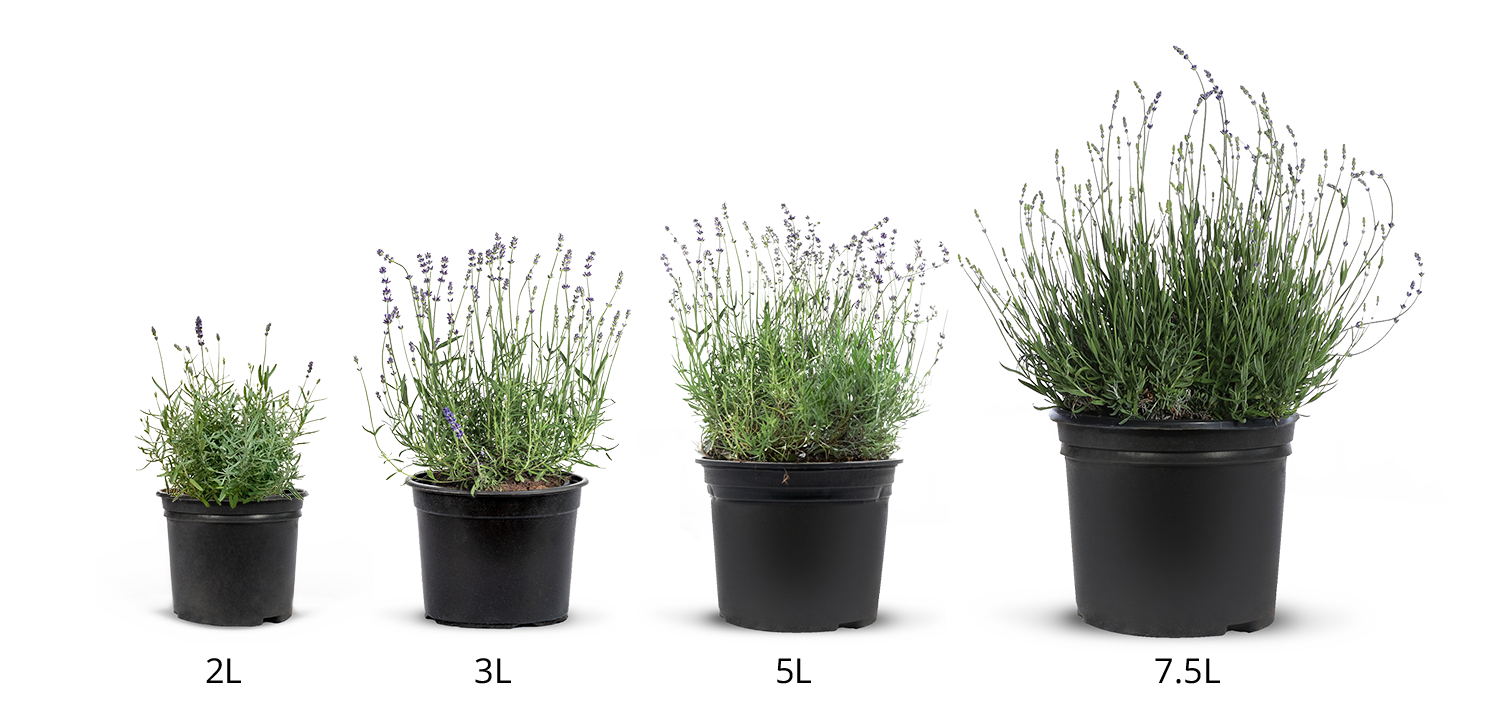
At Greenwood, we are a 100% peat free grower, meaning that every plant across our six nurseries is grown in peat free growing media. Our peat-free journey began in 2022, after assessing our carbon footprint, and we officially reached peat-free status in November 2023. The use of peat compost for commercial growers is set to be banned by the end of 2026, so recognising the significance of growing peat free, and taking the step to transition from peated compost is imperative for growers across the country. We take pride in leading the industry forward in making this change.
Preparation and Planning
Before potting begins, we must first check that everything is in perfect working order. The machines and lines are thoroughly checked to guarantee smooth operation. A list is compiled of what plants are going to be potted, and a date is chosen for when and on which nurseries potting is going to commence. Currently we are potting at our Fresh Acres and Highleigh nurseries, but throughout the year we pot at our Mapletree, Willaston, and Woodpecker nursery sites too. Once the location has been determined, we gather all necessary supplies which are compost, bark, and pots. A plan is formulated detailing the estimated duration, the quantity of plants to be potted, and the daily target.
Production Planning is prepared at the end of the year, and is based on the previous years’ sales figures, as well as projections for the year ahead. We know which plants are ready to pot if they are properly rooted, and if they have reached saleable quality and height.
When we are sure that everything is prepared, we commence potting.
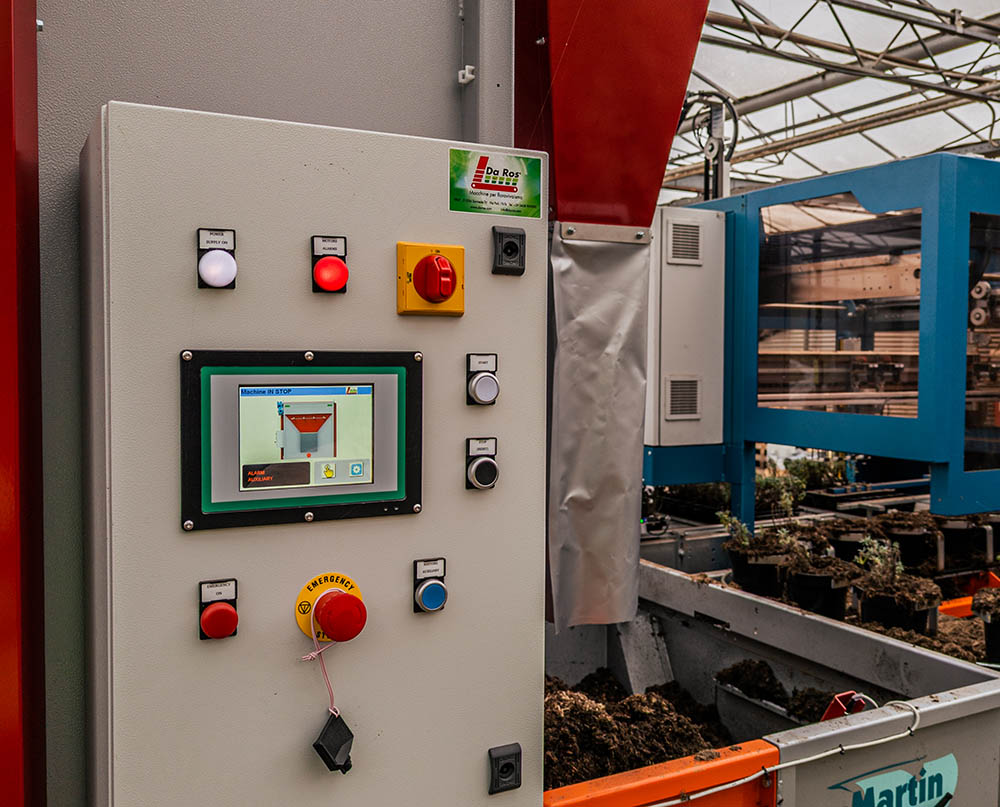
Bale Breaker
Potting in Action
Firstly, a bale breaker is used to break apart compacted bales of growing medium materials into smaller, more manageable pieces. This helps to loosen the material and prepare it for use in the potting mix, ensuring proper aeration and drainage for the plants being potted. Bales are put into the back of the machine and lifted to begin the breaking process from the top, working their way down. The bale goes up gradually within the bale breaker as the loose compost is fed through the chute and into the waiting hopper below. The bale breaker is capable of processing around 15 cubic meters per hour, which greatly increases our potting efficiency. The machine controls the breaking speed to guarantee that the hopper stays at the ideal level and avoids overflow or getting too low. The G team’s production has increased significantly since this equipment was introduced. Prior to its arrival, one of the G team members had to tediously oversee the procedure, carefully adding bales to the hopper with a forklift. Now, it allows us to pot quicker, and with less staff, who can be utilised elsewhere on the nursery.
Next, a potting machine is then used to fill the pots with the growing medium, as well as the plants/seedlings. This speeds up the potting process, ensuring uniformity and efficiency in transplanting each plant into containers.
Our potting machine is the Martin Stolze 3030 Potting Machine. It has an impressive capacity of 7,800 pots per hour and offers various customisation options. These include adjusting its length, pot centre-to-centre size, and the number of pot holders it accommodates. These customisation options are easy to manage using the touch-screen operation. The potting machine places pots into the holders, fills the pots with compost and moves them along on a roller with newly transplanted plants. Using a potting machine gives you a perfectly formed hole into which the plant can be placed, as well as giving you pot size flexibility, and the option for multiple plants to be transplanted in each pot, if required.
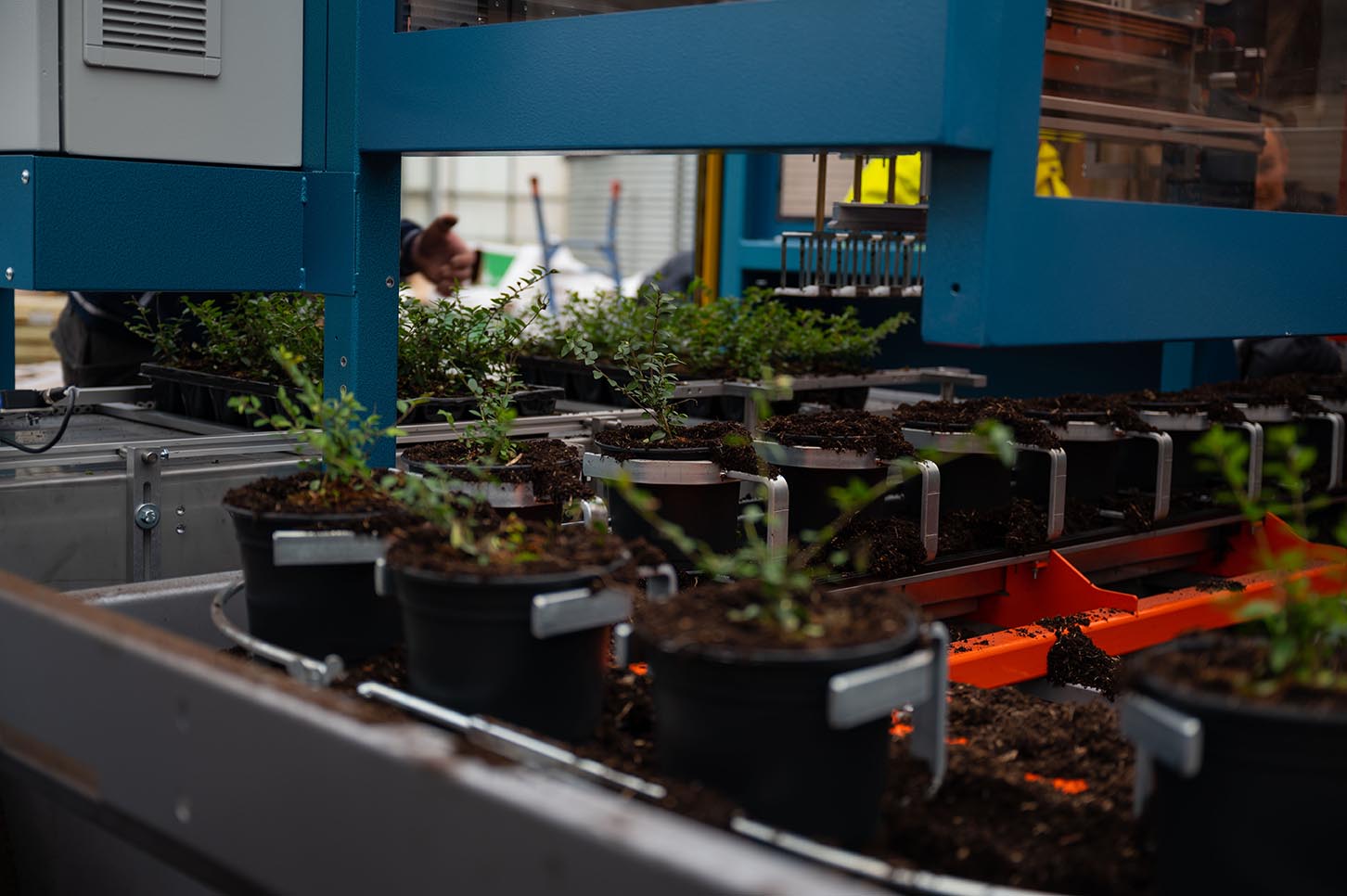
After the pots have been through the potting machine, they go through the bark machine, where each plant is topped with bark. The bark machine is equipped with a hopper, where the bark mulch is loaded. It then moves along a conveyor system within the machine. This conveyor system ensures a steady flow of mulch. At the end of the conveyor system, there’s an application mechanism that evenly distributes the bark mulch onto the surface of potted plants. You can adjust the settings to control the thickness of the mulch layer applied to the pots, which is good for different plant species or pot sizes. The reason we top our plants with bark is because bark mulch allows water to effectively permeate the soil, by softening the impact of rainwater. It also helps to keep weeds at bay, and acts as insulation, shielding plant roots from extreme temperatures, and promoting healthier root systems.
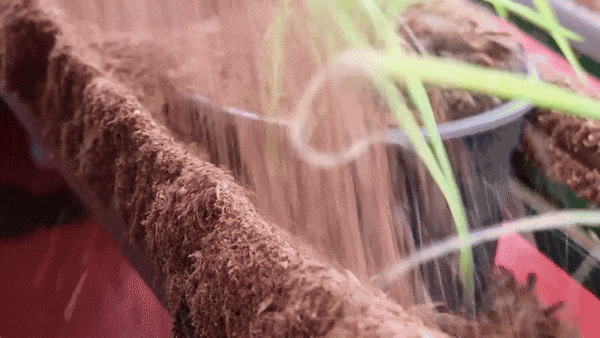
Once the plants have been transplanted into their new pots, they are then transported along conveyor belts. These belts lead to a designated section of the greenhouse, at which point one of the G team will use a spacing fork to separate the pots from the line, placing them evenly and uniformly into the nursery. The efficiency of the potting transport is vital, ensuring a smooth flow of finished pots, and ensuring the full efficiency of the machines is achieved. Challenges arise in maintaining this efficiency, as any disruption could lead to pots falling over, resulting in waste and potential damage to the plants. Attention is therefore given to ensure that the line keeps moving steadily, with proper spacing maintained between each pot, guaranteeing an uninterrupted flow of production and ensuring maximum efficiency from the potting process.
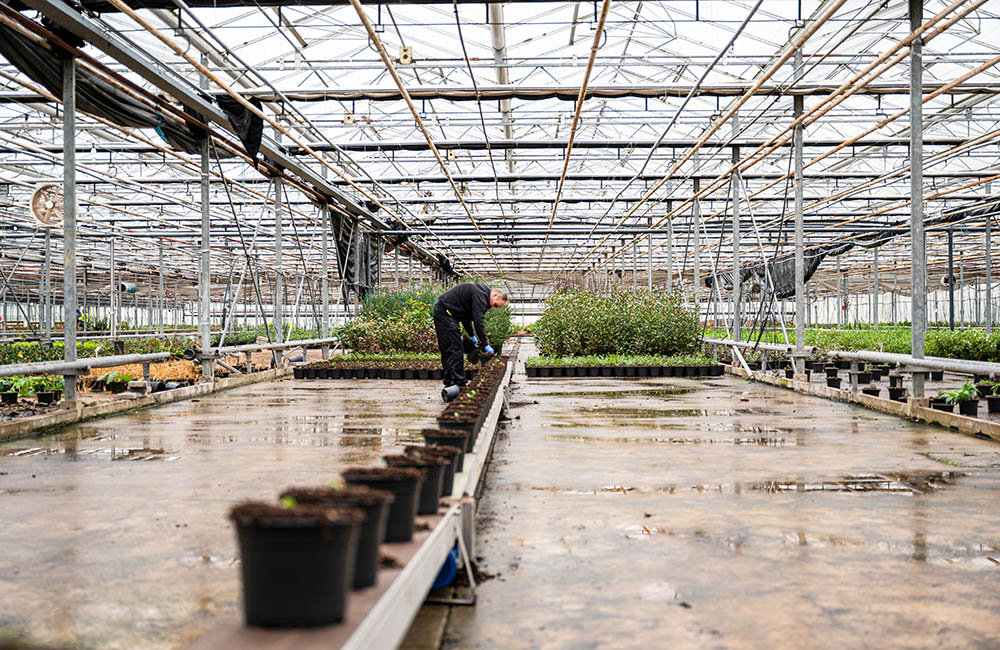
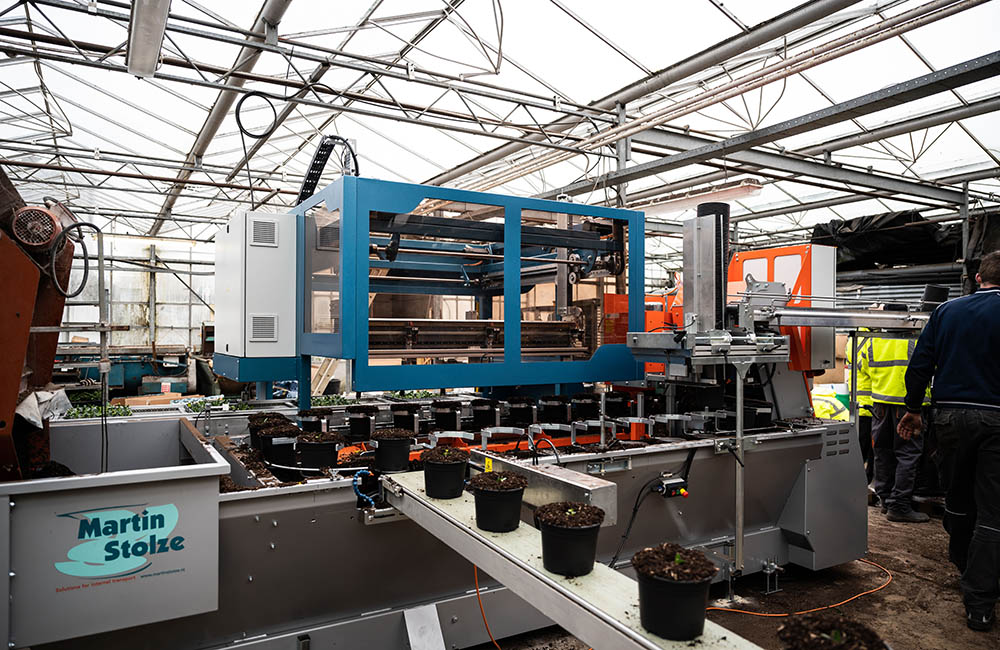
Immediately after potting, the plants must be watered. This is so that the plant gets all the moisture it needs to survive. Moist soil allows the plant to absorb essential nutrients which is very important whilst the plant establishes itself in the soil. To track our progress and ensure accountability, every batch of potted plants is signed off at the start and end of the process. This also helps us to maintain consistency and quality. By tracking batches of potted plants from start to finish, it allows for easier identification and management of any issues related to pests and diseases, or other biosecurity concerns, as well as the general quality. If a problem is detected in a particular batch, it can be isolated and addressed more efficiently, potentially preventing its spread to other batches or areas.
During spring 2024 our target is to pot 600,000 plants across all of our nursery sites. In a whole year, we aim to pot roughly 2.5 million plants. That’s enough growing medium to cover 23 football fields an inch thick!
Once the plants are potted, it’s important to monitor growth, and assess when it’s time to repot them once more. Our team check the plants to make sure they have roots, and once they are rooted properly, we know it’s time to repot. This means each plant can continue to thrive with optimised healthy growth and development.
Our potting process is all about precision, care, and dedication. From meticulous preparation to execution, every step is taken to ensure that each plant receives the attention it needs. As we say, Every Plant Matters!
To see how our plants can transform your landscaping projects, get in touch with the G team today.

